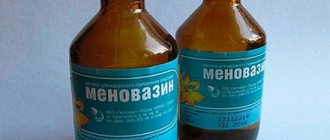Nimopine
Xenobiotics that affect the activity of cytochrome CYP3A4 may alter the metabolic clearance of nimodipine.
Based on the experience of using nifedipine, it can be expected that rifampicin, by inducing the activity of liver enzymes, can accelerate the metabolism of nimodipine and, when used simultaneously, the effectiveness of nimodipine is reduced.
Previous long-term administration of microsomal oxidation inducers (phenobarbital, phenytoin or carbamazepine) increases the metabolism of nimodipine.
Grapefruit juice inhibits the metabolism of dihydropyridines. The combination of grapefruit juice and nimodipine should be avoided because this may result in unpredictable increases in nimodipine plasma concentrations. Concomitant use of nimodipine with cimetidine or valproic acid may also lead to increased plasma concentrations of nimodipine.
The combined use of nimodipine and fluoxetine is accompanied by an increase in the concentration of nimodipine in plasma (by 50%), while the concentration of fluoxetine is significantly reduced, and the concentration of its active metabolite norfluoxetine remains unchanged.
Simultaneous long-term use of nimodipine and nortriptyline leads to a slight decrease in the concentration of nimodipine (while the concentration of nortriptyline in the blood plasma does not change). In patients on long-term therapy with haloperidol, no drug interactions between nimodipine and haloperidol were detected.
Nimodipine, when administered intravenously with zidovudine, leads to a significant increase in the area under the concentration-time curve (AUC) of the latter and a decrease in its volume of distribution and clearance.
Suppresses the metabolism of prazosin and other alpha-blockers, as a result of which the hypotensive effect may be enhanced.
In patients taking antihypertensive drugs (diuretics, beta-blockers, angiotensin-converting enzyme inhibitors, angiotensin II receptor antagonists, other BMCCs, alpha-blockers, methyldopa, sympatholytics, etc.), the administration of Nimopin increases the severity of the hypotensive effect. Because of this, intravenous administration of beta-blockers is not permissible during the use of nimodipine.
Caution should be used concomitantly with disopyramide, flecainide, procainamide, quinidine and other drugs that cause prolongation of the QT interval (possible increased severity of negative inotropic effects and prolongation of the QT interval).
The simultaneous administration of potentially nephrotoxic drugs (for example, aminoglycosides, cephalosporins, furosemide) with nimodipine can lead to impaired renal function. If their simultaneous use is necessary, as well as in patients with renal failure, treatment should be carried out under careful monitoring of renal function. If renal dysfunction is detected, nimodipine should be discontinued.
Strengthens the arrhythmogenic effect of drugs that promote the excretion of potassium ions. Increases the risk of developing side effects of cardiac glycosides, quinidine, carbamazepine, cyclosporine, theophylline, valproic acid, lithium preparations.
The hypotensive effect is enhanced when administered simultaneously with inhalational anesthetics.
The hypotensive effect is reduced by sympathomimetics, non-steroidal anti-inflammatory drugs (suppression of prostaglandin synthesis, sodium and fluid retention in the body), estrogens (fluid retention in the body).
Nimopin
Nimodipine is metabolized by the CYP3A4 isoenzyme, so its inducers and inhibitors may affect the first step of metabolism (after oral administration) or the clearance of nimodipine.
The combined use of nimodipine and fluoxetine is accompanied by an increase in the concentration of nimodipine in plasma (by 50%), while the concentration of fluoxetine is significantly reduced, while the concentration of its active metabolite norfluoxetine remains unchanged.
Long-term use of nimodipine with nortriptyline leads to a slight increase in plasma concentrations of nimodipine; the concentration of nortriptyline remains unchanged.
Previous long-term administration of phenobarbital, phenytoin or carbamazepine significantly reduces the bioavailability of nimodipine when taken orally (simultaneous oral therapy with nimodipine and these anticonvulsants is not recommended).
Based on the experience with the use of another BMCC, nifedipine, it can be expected that rifampicin is able to accelerate the metabolism of nimodipine, inducing the activity of liver enzymes, i.e. with simultaneous use of rifampicin and nimodipine, the effectiveness of the latter may be reduced.
Grapefruit juice inhibits dihydropyridine oxidation metabolism. The combination of grapefruit juice and nimodipine should be avoided because this may lead to increased plasma concentrations of nimodipine.
Concomitant use of nimodipine with cimetidine or valproic acid may lead to increased plasma concentrations of nimodipine.
Ranitidine and famocidine do not have a significant effect on the metabolism of BMCC.
Suppresses the metabolism of prazosin and other alpha-blockers, as a result of which the hypotensive effect may be enhanced.
No drug interactions between nimodipine and haloperidol were found in patients on long-term haloperidol therapy.
In patients with high blood pressure taking antihypertensive drugs, nimodipine may enhance their effect. While using nimodipine, beta-blockers should not be administered intravenously (risk of a significant decrease in blood pressure).
Procainamide, quinidine and other drugs that cause prolongation of the QT interval enhance the negative inotropic effect and may increase the risk of significant prolongation of the QT interval.
Nimodipine increases the risk of developing renal dysfunction due to nephrotoxic drugs (aminoglycosides, cephalosporins).
Strengthens the arrhythmogenic effect of drugs that promote the excretion of K+.
Increases the risk of developing side effects of cardiac glycosides, quinidine, carbamazepine, cyclosporine, theophylline, valproate, Li+ salts.
The hypotensive effect is enhanced by simultaneous administration with beta-blockers, other BMCCs, inhalational anesthetics or sympatholytic drugs.
The hypotensive effect is reduced by sympathomimetics, NSAIDs (suppression of Pg synthesis in the kidneys and Na+ and fluid retention in the body), estrogens (fluid retention in the body).
Ca2+ preparations reduce the effectiveness of nimodipine.
It is absorbed by polyvinyl chloride, so only polyethylene infusion systems should be used for intravenous administration.
Nimopin 0.2 mg/ml 50 ml 1 pc. solution for infusion bottle + connecting tube
pharmachologic effect
Selective class II calcium channel blocker, dihydropyridine derivative.
Selectively interacts with type L calcium channels and blocks the transmembrane entry of calcium ions. It has a vasodilating effect mainly on the vessels of the brain. Prevents or eliminates vasospasm caused by various vasoconstrictor biologically active substances. Causes a more pronounced increase in perfusion in areas of the brain with insufficient blood supply (compared to areas with normal blood supply). Improves cerebral circulation in subarachnoid hemorrhage. Stabilizes the functional state of brain neurons. Improves memory and ability to concentrate.
It does not have a significant effect on systemic blood pressure, has virtually no effect on conductivity in the AV and sinoatrial nodes and on myocardial contractility. Reflexively increases heart rate in response to vasodilation.
Composition and release form Nimopin 0.2 mg/ml 50 ml 1 pc. solution for infusion bottle + connecting tube
Solution - 1 ml/1 vial: nimodipine 200 mcg 10 mg.
50 ml - dark glass bottles (1) complete with a connecting tube - cardboard packs.
Directions for use and doses
When taken orally, a single dose is 30-60 mg, the frequency of administration and duration of use depend on the indications.
For IV or intracardiac administration, the dose is set individually.
Pharmacokinetics
When taken orally, it is quickly absorbed from the gastrointestinal tract, Cmax in plasma is reached within 1 hour. It is subjected to intensive metabolism during the “first pass” through the liver. Bioavailability is low. Plasma protein binding is 95%. T1/2 in the initial phase is 1-2 hours, in the terminal phase - 8-9 hours. It is excreted by the kidneys (less than 1% unchanged) and through the intestines.
Indications for use Nimopin 0.2 mg/ml 50 ml 1 pc. solution for infusion bottle + connecting tube
Cerebrovascular insufficiency (including acute cerebral ischemia, decreased memory and ability to concentrate, mood lability). Treatment of residual effects of cerebrovascular accident and conditions after surgery for subarachnoid hemorrhage.
Contraindications
Severe arterial hypertension, pregnancy, lactation, hypersensitivity to nimodipine.
Application Nimopin 0.2 mg/ml 50 ml 1 pc. solution for infusion bottle + connecting tube during pregnancy and breastfeeding
Contraindicated for use during pregnancy and lactation (breastfeeding).
special instructions
Use with caution in cases of severe bradycardia, chronic heart failure, mild or moderate arterial hypotension, myocardial infarction with left ventricular failure, intracranial hypertension, and generalized edema of brain tissue.
In case of impaired renal function and in elderly patients, adjustment of the dosage regimen is required.
Impact on the ability to drive vehicles and operate machinery
Patients taking nimodipine should refrain from engaging in potentially hazardous activities that require increased attention and speed of psychomotor reactions.
Side effects Nimopin 0.2 mg/ml 50 ml 1 pc. solution for infusion bottle + connecting tube
From the cardiovascular system: decreased blood pressure, bradycardia, hot flashes, the occurrence or worsening of existing heart failure, extrasystole, angina pectoris (up to the development of myocardial infarction, especially in patients with severe obstructive lesions of the coronary arteries), arrhythmias (including short-term ventricular flutter, ari); rarely - excessive decrease in blood pressure, tachycardia, transient visual impairment.
From the digestive system: nausea, diarrhea, discomfort in the gastrointestinal tract, dyspeptic symptoms, transient increase in the activity of transaminases, GGT and alkaline phosphatase in the blood plasma, gum hyperplasia (bleeding, pain, swelling), constipation, dry mouth, increased appetite.
From the side of the central nervous system: dizziness, headache, asthenia, extrapyramidal disorders, symptoms of central nervous system excitation (insomnia, increased psychomotor activity, agitation, aggressiveness), depression, fatigue, drowsiness.
From the respiratory system: difficulty breathing, cough, pulmonary edema, wheezing.
From the hematopoietic system: thrombocytopenia, agranulocytosis.
Allergic reactions: rarely - skin rash.
Other: pain and swelling of the joints, increased sweating, decreased kidney function (increased urea concentration, hypercreatininemia), galactorrhea, increased body weight, swelling of the feet and legs.
Drug interactions
When used simultaneously with antihypertensive drugs, the antihypertensive effect may be enhanced.
When used simultaneously with beta-blockers, severe arterial hypotension and an increased risk of developing heart failure are possible.
When used simultaneously with aminoglycosides, cephalosporins, furosemide, renal function may be impaired.
When used simultaneously with sodium valproate, the concentration of nimodipine in the blood plasma increases; with phenobarbital, phenytoin, carbamazepine, the bioavailability of nimodipine is significantly reduced.
When used simultaneously with cimetidine, a slight increase in the concentration of nimodipine in the blood plasma and an increase in its antihypertensive effect are possible.

